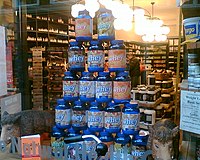
Photo from wikipedia
INTRODUCTION The daily protein recommendation for adults is 0.8 g/kg/day; however, several studies argue that an intake of 1.0-1.5 g protein/kg/day could benefit the health of the elderly. OBJECTIVE We… Click to show full abstract
INTRODUCTION The daily protein recommendation for adults is 0.8 g/kg/day; however, several studies argue that an intake of 1.0-1.5 g protein/kg/day could benefit the health of the elderly. OBJECTIVE We evaluated the protein intake and serum lipid levels in elderly patients with hip fracture, determining their correlation with the grip strength in both hands. METHODS The study included 47 adult patients aged 65-85 years hospitalized for recent hip fracture. Weight, height, lipid profile and muscle strength of both hands were measured, and MNA was also used to evaluate the nutritional status. RESULTS The elderly, predominantly women and with a homogeneous age of 80 years on average, were malnourished or at risk of malnutrition in 93% of cases according to the MNA. Men consumed significantly more protein than women. Muscle strength negatively associated with triglyceride levels; 36% of the elderly had triglyceride levels above 150 mg/dl. CONCLUSIONS TG levels associated inversely with muscle strength in elderly patients with hip fracture. According to these results, which should be validated in other populations, elevated TG levels are a factor of metabolic syndrome and are associated with low muscle strength in the elderly. This is relevant because obesity prevention and metabolic syndrome are one priority through the promotion of healthier lifestyles and nutrition policies that could be widely implemented.
Journal Title: Nutricion hospitalaria
Year Published: 2018
Link to full text (if available)
Share on Social Media: Sign Up to like & get
recommendations!